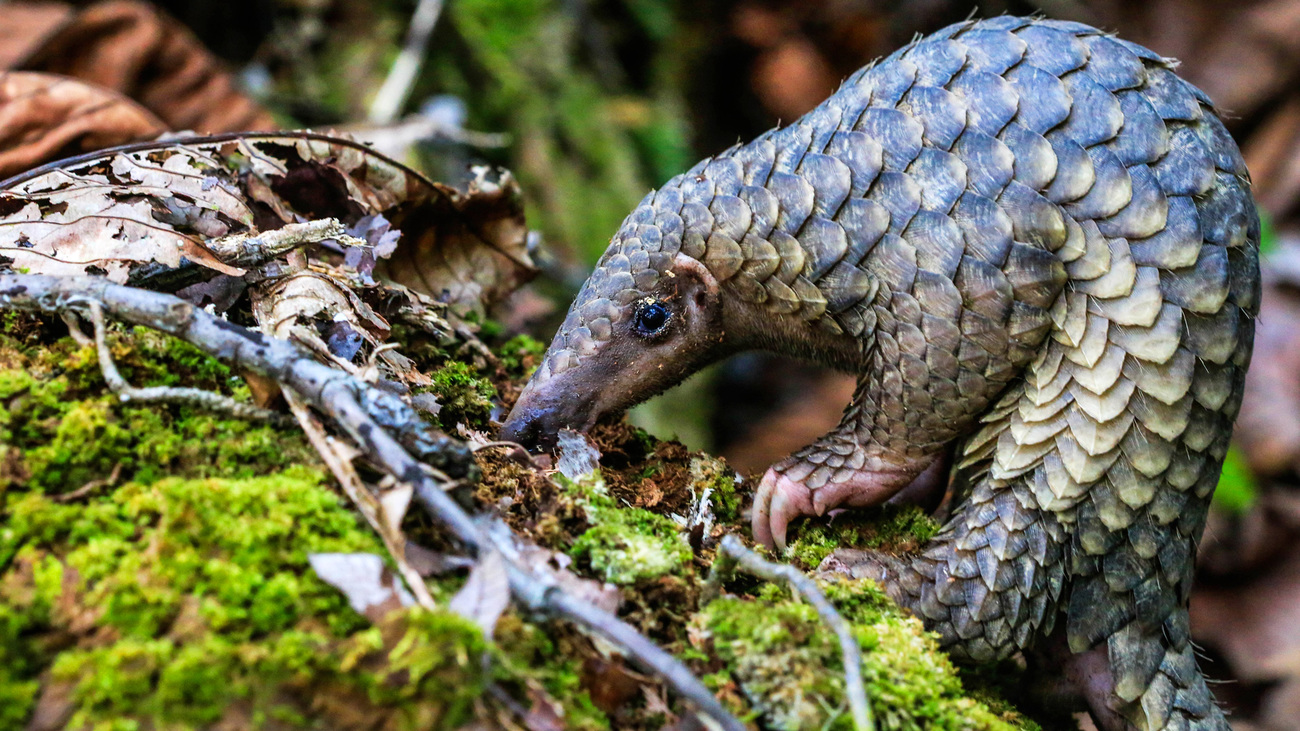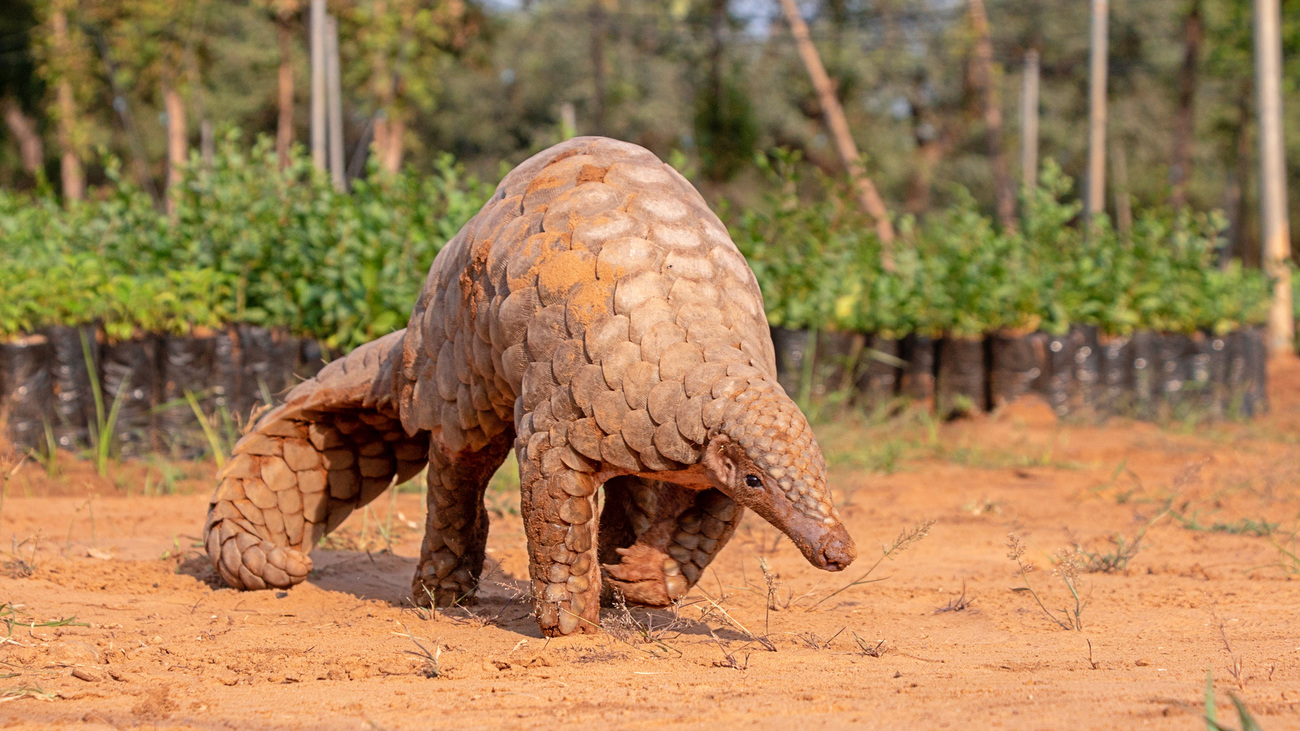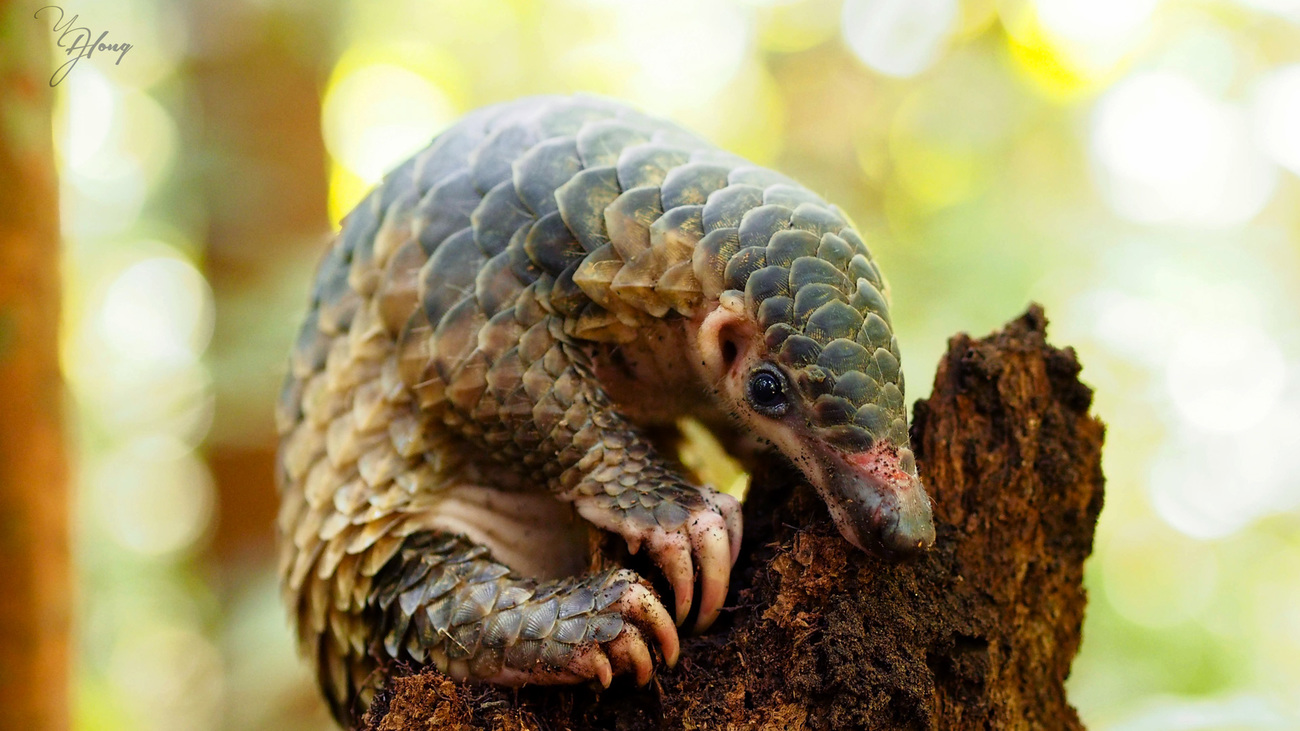Pangolin facts: Learn about the world’s most trafficked mammal
Pangolin facts: Learn about the world’s most trafficked mammal
Pangolins are one of the most trafficked animals in the world, but you may have never heard of them. If that’s the case, it’s time to learn everything there is to know about the pangolin—because these amazing animals are in urgent need of our help.

What are pangolins?
Pangolins are a unique group of insect-eating animals, feeding mainly on termites and ants. They may look like reptiles, with their bodies covered in overlapping scales, but they’re actually mammals! Pangolins are about the size of a house cat, with small heads, long snouts, and thick tails. These prehistoric mammals, which have been around for 80 million years, are now threatened with extinction.
Did you know that pangolins are the only mammals in the world covered in scales? Made of keratin—the same material that makes fingernails and hair—the pangolin’s sand-coloured scales protect it from predators. When threatened, pangolins roll into a tight ball to shield their soft underparts (and if the idea of a yellow-coloured creature covered in scales and curled up into a ball sounds familiar, you might be thinking of the Pokémon Sandshrew, which is often said to be partly modelled based on a pangolin).
Pangolins are solitary animals. They usually live by themselves and do most of their hunting at night. They only seek out other pangolins when it’s time to mate. After a gestation period of 70 to 140 days, baby pangolins ride on their mother’s tails until they’re weaned, and surprisingly, it’s not uncommon for the fathers to stay with the family until the offspring are independent.
There are eight species of pangolin which are split into two main groups—African pangolins and Asian pangolins.
How big are pangolins?
Each species of pangolin is a slightly different size, ranging from around 114 centimetres (45 inches) to 137 centimetres (54 inches) long. Different species also have different-sized tails, with the tree-climbing pangolins having much longer tails than the ground pangolins. The longest tail belongs to the black-bellied (or long-tailed) pangolin, and it can reach up to two times the length of its body.
How much do pangolins weigh?
The different species of pangolin vary in size. The smallest, the black-bellied pangolin, weighs around 1.6 kilograms (3.5 pounds), while the largest, the giant ground pangolin, can reach 33 kilograms (73 pounds).
Where do pangolins live?
Pangolins are native to Africa and Asia. They can be found in woodland and savannah habitats. Some live in trees while others live on the ground. The tree-climbing species make homes for themselves in hollow trees, while the ground-dwelling species dig deep burrows for nesting.
What do pangolins eat?
Pangolins are often referred to as scaly anteaters, and for good reason—they use their long, sticky tongues, which can extend up to 40 cm (16 inches), to slurp up ants. Their diets also include termites, larvae, flies, worms, and crickets. Because they hunt at night and have poor eyesight, pangolins usually locate nests through their sense of smell. They use their long, sharp claws to dig into nests and reach their prey, and when the insects fight back, they use special muscles to close off their nostrils and ears to prevent unwanted visitors.
Fun fact: A single pangolin can consume 70 million insects per year.
What are the different types of pangolins?
There are eight living species of pangolins. Four of those species are found in Africa: black-bellied pangolins (Phataginus tetradactyla), tree pangolins (Phataginus tricuspis), giant ground pangolins (Smutsia gigantea), and Temminck’s pangolins (Smutsia temminckii). The other four pangolin species live in Asia: Indian pangolins (Manis crassicaudata), Philippine pangolins (Manis culionensis), Sunda pangolins (Manis javanica), and Chinese pangolins (Manis pentadactyla).
Do pangolins lay eggs?
Pangolins don’t lay eggs. Males and females mate once a year, and the females give birth to between one and three live offspring at a time. Baby pangolins (also known as pangopups) are born covered in soft, white scales that harden after a couple of days. A baby pangolin will ride on its mother’s back by clinging to her scales.
Are pangolins related to armadillos?
Pangolins and armadillos are both mammals, like us, but they’re not considered close relatives to one another. Pangolins and armadillos do look similar, but pangolins are actually more closely related to dogs, cats, and bears than they are to armadillos.

Are pangolins dangerous?
Pangolins are more afraid of you than you are of them. These shy, insectivorous creatures won’t attack a human. When threatened, they resort to coiling into a tight sphere in self-defence, relying on their sharp scales to deter predators.
Do pangolins make good pets?
Pangolins make terrible pets, and it is illegal to own them. They are not well-suited to living in any environment outside of their natural habitat. In fact, many zoos that have tried to house pangolins have found that most die within their first year out of the wild due to stress or dietary issues. It’s also important to remember that keeping wild animals is dangerous for humans and domesticated animals, primarily due to the potential spread of zoonotic diseases. The exotic pet trade is also unethical due to the poor conditions in which the animals are kept as they are transported and the traumatic process of removing them from the wild, which often involves tearing young animals away from their families or killing other animals in the process.
Despite this, pangolins are unfortunately part of the exotic pet trade, as well as the international trade for traditional medicine. At IFAW, we’re working hard to protect pangolins from the poaching crisis they’re facing, and together with other NGOs, we succeeded in upgrading pangolins from Appendix II of CITES to Appendix I. This prohibits the international trade of pangolins and their body parts.
Why are pangolins trafficked?
Pangolins are the most trafficked mammals in the world due to high demand for their scales and claws in traditional medicine. Their meat is considered a delicacy in some Asian countries and consumed as bushmeat in some African countries. All eight species are now threatened with extinction, and three species—the Chinese pangolin, the Philippe pangolin, and the Sunda pangolin—are listed as critically endangered.
Although there are now international trade bans in place to protect pangolins, trafficking continues to be a problem—and it’s difficult to prevent or seize all illegal shipments of wildlife products. As long as demand for the product survives, new poachers and trading groups will keep appearing.
It’s important to note that, although most poached pangolins are used for food or medicine, they are not an essential commodity. The meat is usually sent to far-off countries as a needless luxury, and medical science doesn’t recognise any medicinal benefits in pangolin scales.
What are pangolin scales used for?
In traditional medicine, pangolin scales are believed to improve circulation, reduce inflammation, stimulate lactation, and relieve skin diseases, even though there is no scientific evidence that they provide any health benefits.
What are pangolin scales made of?
Pangolin scales are made out of the same hardened protein—keratin—as human hair and fingernails. Depending on the species, they can be sandy yellow, light brown, olive, or almost black. These scales grow across their entire upper side and overlap to avoid exposing skin when they move. A pangolin’s belly and underside, however, are not covered in scales, which is why they roll up in a ball when they’re in danger.
How many pangolins are left in the world as of 2024?
Pangolins are notoriously difficult to monitor because they are shy and nocturnal, making accurate estimates of their population size hard to determine. Conservationists, however, are confident that all eight species are declining based on other methods.
Here is the latest information from the IUCN on the condition of each species:
- Sunda pangolin: critically endangered, with a decreasing population trend
- Philippine pangolin: critically endangered, with a decreasing population trend
- White-bellied pangolin: endangered, with a decreasing population trend
- Temminck’s pangolin: vulnerable, with a decreasing population trend
- Indian pangolin: endangered, with a decreasing population trend
- Black-bellied pangolin: vulnerable, with a decreasing population trend
- Giant ground pangolin: endangered, with a decreasing population trend
- Chinese pangolin: critically endangered, with a decreasing population trend
Due to their nocturnal and solitary lives and increasing rarity, no formal estimates can be made on the number of pangolins left. It’s also important to note that all pangolin species were last assessed by the IUCN in 2018 or 2019, so we don’t have any information from the past five years.

How can we protect pangolins?
If you live in the US, you can ask your senators to support the Preventing Future Pandemics Act—a bipartisan bill that will stop the trade in live wild animals, including pangolins, for food and medicine.
Related content
Every problem has a solution, every solution needs support.
The problems we face are urgent, complicated, and resistant to change. Real solutions demand creativity, hard work, and involvement from people like you.